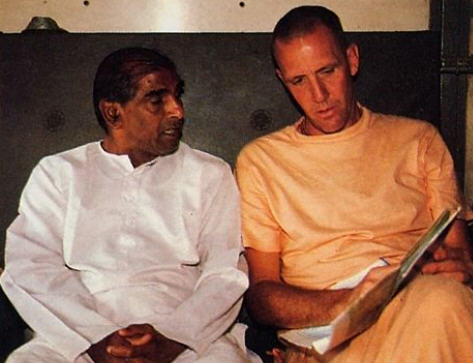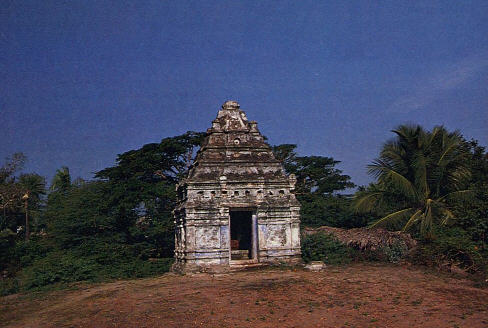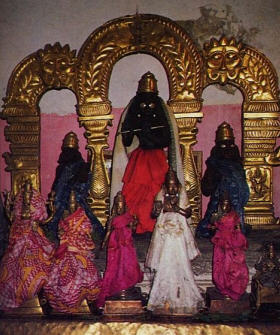Lord Caitanya visited this sacred place more than four centuries ago,
yet His instructions to one of its residents are remembered even today.
It was early April when our group of four devotees from the United States arrived in Calcutta. We were on pilgrimage to Kurmaksetra, a remote holy place on the southeastern coast of India.

Jagatguru Swami
To the people of South India, Kurmaksetra is an important holy place owing to its magnificent temple of Sri Kurma, a Deity of Lord Visnu, the Personality of Godhead, in the form of a kurma, or tortoise. Kurma-avatara is one of the ten incarnations of Godhead known in India as Dasavatara. As described in Bhagavad-gita, the incarnations of Godhead appear in this world to deliver the devotees and vanquish the miscreants.
The Srimad-Bhagavatam explains that during the early days of the universe Lord Visnu appeared as Kurma to help the demigods and demons produce the nectar of immortality by churning the milk ocean. Lord Kurma submerged Himself within the ocean, and His back became the pivot for Mandara Mountain, which was used as a churning rod. By the Lord's arrangement, the nectar produced was distributed only to the demigods.
We were eager to visit Kurmaksetra because even though the pastimes of the Kurma-avatara have been widely portrayed throughout India's history in paintings, sculpture, literature, songs, and drama, the temple of Sri Kurma at Kurmaksetra is unique, for no other temple of Lord Kurma has ever existed.
There was another reason for our pilgrimage: we wanted to retrace the footsteps of Lord Caitanya Mahaprabhu. The Caitanya-caritamrta describes Lord Caitanya's visit to Kurmaksetra during His travels through South India almost five hundred years ago. At Kurmaksetra as in all the places He visited Lord Caitanya introduced the sankirtana movement by dancing in ecstasy and chanting the Hare Krsna maha-mantra:Hare Krsna, Hare Krsna. Krsna Krsna. Hare Hare/ Hare Rama, Hare Rama. Rama Rama, Hare Hare. Lord Caitanya Mahaprabhu taught that in this age no other process for self-realization is as effective as the congregational chanting of the holy names of God.
It was typically hot and humid when we arrived in Calcutta. After refreshing ourselves at our hotel, we went straight to the Government of India Tourist Bureau and purchased four train tickets to Kurmaksetra via Sri Kakulam.
The next morning, we were up early, and by 4:30 we were in a taxi headed for Howrah Station. There is no such thing as "beating the rush hour" in Calcutta. At the Howrah bridge, which crosses the Ganges River, the cars and buses were already bumper to bumper.
At the station we struggled through the crowds and haggled with the porters over price. Once inside the train, we put our baggage under the seats and waited. The train was twenty passenger cars pulled by an old steam-powered locomotive. At 6:30 the engineer blew the whistle, and the train inched away from the platform. After around forty-five minutes the train cleared the outskirts of the city, and we enjoyed watching the Bengal countryside pass by our window.
By late afternoon we entered the state of Orissa, which marked a significant change in scenery from lush green jungle to semi-arid plains. I took out my Bartholomew map of the Indian subcontinent and marked our route along the coast. We chanted Hare Krsna on our beads and read Bhagavad-gita as we rumbled along.
The next day an Indian gentleman entered our cabin. He wore traditional Hindu clothing, a white cotton shirt and matching pants. "Yes, you can sit here, sir," I said, pointing to the seat next to me. The gentleman sat down and introduced himself as Mr. Gopalam Dosi. Mr. Dosi said this was the first time he had ever met Western devotees of Lord Krsna. He said our meeting was God's arrangement.
When I asked Mr. Dosi where he was from, he said, "Kurmaksetra. Are you going there?" "Yes!" I replied. "We are on pilgrimage." I explained to Mr. Dosi that we were members of the International Society for Krishna Consciousness and that our mission was to spread Krsna consciousness all over the world. I mentioned that Lord Caitanya Mahaprabhu wanted everyone born in India to preach Krsna consciousness. In a half-serious tone I suggested that Mr. Dosi might take sannyasa, the renounced order of life, and become a preacher of Lord Caitanya's movement. "Yes," he said, "that would be good. But we are householders; our duty is to stay at home."
"Perhaps you know," he continued, "Caitanya Mahaprabhu came to Kurmaksetra a long time ago. He told the people of our village to remain in their homes and chant the name of Krsna." I was surprised to hear Mr. Dosi's conviction about chanting Krsna's name, and I was especially surprised to hear him mention Lord Caitanya.

A Small Shrine House The Footprints of Lord Caitanya
The Caitanya-caritamrta describes that when Lord Caitanya came to Kurmaksetra, He stayed in the house of a local brahmana. When the Lord was preparing to leave, the brahmana wanted to take sannyasaand travel with Him, but Lord Caitanya forbade him to do so. He instructed the brahmana to remain at home and always chant the holy name of Krsna. Lord Caitanya said, "Don't speak like that again. Better to remain at home and chant the holy name of Krsna. Instruct everyone to follow the orders of Lord Krsna as they are given in Bhagavad-gita and Srimad-Bhagavatam. In this way become a spiritual master and try to liberate everyone in this land. If you follow this instruction, your materialistic life at home will not obstruct your spiritual advancement. If you follow these regulative principles, we will again meet here, or rather, you will never lose My company."
While speaking with Mr. Dosi. we became absorbed in thoughts of Lord Caitanya's sankirtana movement and became more eager to see the temple of Sri Kurma.
Suddenly the train began to slow down. The conductor stuck his head into our compartment and announced, "Sri Kakulam! Next stop, Sri Kakulam." Mr. Dosi turned to me and said. "This is where we get off." When the train came to a stop at the platform, we parted company.
The railway station was about ten miles from the center of town. We spent the night in a hotel and were up early the next morning, intent on seeing some of the temples in Sri Kakulam before going on to Kurmaksetra. It was still a little dark when we left our room and went out onto the street, already alive with activity. People we re moving about performing their morning duties drawing water from the neighborhood well, milking the family cow, and going to and from the temples for morning worship.
As light began to appear on the horizon, we met with a group of local chanters three men emerged from the dawn playing musical instruments and chanting the maha-mantra. What a wonderful sight! It was as if they had appeared from the pages of Caitanya-caritamrta. At their request we joined in the chanting and continued along the road.
Shortly we came to a small neighborhood temple. After more chanting we sat down and got acquainted with our new friends. Each of the men owned a small business in the marketplace but came out on the chanting party each day before going to work. They begged us to continue with them, but we had to start for the temple of Sri Kurma, and so we bid farewell.
Boarding a fifty-two-seat bus with at least seventy-five other passengers, we began our twenty-two-mile journey to the village of Kurmaksetra. Half the passengers were pilgrims, and the other half were local farmers. The bus stopped along the road about every mile or so to either pick someone up or drop someone off. Within an hour we arrived at Kurmaksetra.
Getting off the bus, we decided to follow the flow of the other pilgrims. We walked along the narrow village streets filled with children at play and past the thatched-roof dwellings until we came to a still lake. Looking across, we got our first view of the ancient temple of Sri Kurma.
Rows of stone steps led up from the lake toward the temple. Beyond a stand of palm trees towered the temple gate and the main shrine of the Deity. Our path led us around the left bank, and as we drew nearer, many of the pilgrims began to run toward the temple as if it might vanish before they could reach it. Their enthusiasm was like that of small children about to fulfill their heart's desire.

Deities of Sri Kakulam
When we reached the main entrance, many pilgrims were sitting and waiting. The temple doors were closed. It would be another hour before they opened. So, cameras in hand, we began to circumambulate the outer wall of the temple.
On the way, a village boy started to tag along. He turned out to be a guide and offered to show us around for one rupee. On the southern side of the temple, we came upon a small shrine perched on a knoll. As we approached the shrine, the boy said, "Mahaprabhu pada, Mahaprabhu pada." I understood that he was saying, "Mahaprabhu's feet," but I wasn't quite sure what he meant. When we reached the shrine, the boy went inside and pointed, "Here." We looked inside and saw two large footprints in a marble slab. Below, an inscription in Telegu read: "Mahaprabhu visited Kurmaksetra in A.D. 1512. Caitanya footprints installed by Paramahamsa Bhaktisiddhanta Sarasvati Gosvami in 1930."
Srila Bhaktisiddhanta Sarasvati Thakura, the spiritual master of our spiritual master, Srila Prabhupada, had the shrine built to commemorate Caitanya Mahaprabhu's pilgrimage to Kurmaksetra. Srila Bhaktisiddhanta had laid the footprints in their place. As we stood by the shrine, we felt the inspiring presence of our parama-guru. Now there was a third dimension to our pilgrimage: we were following in the footsteps of Srila Gosvamis.
Suddenly, conchshells blew and the temple bells rang, announcing the opening of the temple doors. Our hearts leaped, and we ran toward the temple.
Leaving our shoes behind, we merged in the column of pilgrims passing through the massive doorway. The temple was vast a seemingly endless array of sculptured stone columns, colonades, corridors, domes, and passageways. We crossed a large, open courtyard in which stood a bronze pillar with Garuda, the great carrier of Visnu, at the top. In an awesome mandapa (pavilion) with five hundred magnificent pillars, each with a different design, a group of musicians sat playing classical South Indian melodies. The sounds of the drums, hand cymbals, and shenai (wind instrument) created a celestial atmosphere. At the far end of the courtyard we entered a small corridor barely wide enough to allow more than two people through at a time.
Now our progress was slow. The way was dimly lit by occasional ghee lamps along the walls. The scents of ghee smoke, sandal, and camphor mixed in the air. The only sound was the murmuring of prayers as we inched our way forward through the winding passage. With only a few feet to go the air surcharged with feelings of devotion-we stood humbly with folded hands waiting our turn.
Then we entered the ancient Deity sanctum. It was gorgeous. The room was well lit by burning torches. The walls and ceiling were adorned with colorful paintings depicting the pastimes of the ten incarnations of Visnu. From the high ceiling hung a thousand-petaled stone lotus. The highly polished black-and-white marble floor reflected everything in the room.
Bare-chested brahmana priests wearing white silk dhotis and adorned with marks of tilaka (sacred clay) on their foreheads, arms, and torsos, moved about the room as they performed their duties of administering sacred rites to the pilgrims. On the left side of the sanctum stood the main altar, covered in silver and decorated with flowers and the leaves of the tulasi plant.
There we saw the Deity of Sri Kurma, with His raised back. He was wearing a golden crown studded with valuable jewels and topped with a peacock feather, the symbol of the Visnu avataras.
To the right stood another altar, where the consorts of Lord Visnu known as Sri Devi and Bhu Devi were being worshiped in great opulence. The room was filled with the fragrance of incense, and flickering light from torches and ghee lamps danced along the ancient stone walls.
A brass chain stretching between two pillars kept us from going farther. The brahmanas were busy presenting offerings of fruits and flowers to the Deity. Suddenly one of the brahmanas noticed us and turned to us with folded hands. Removing the brass chain, he beckoned us to come closer. We were now standing right next to the altar of Sri Kurma.
The brahmana asked our names and began chanting Vedic hymns, requesting the Deity to bestow mercy and good fortune upon us. Then we were each given caranamrta three drops of sacred water-in the palm of our hand. The Vedic scriptures state that whoever takes caranamrta before the Deity of Lord Visnu becomes free from the miseries of material existence and becomes eligible to enter into the eternal kingdom of God.
The head priest then came before each of us and placed upon our head a large pair of silver slippers marked with the four symbols of Visnu-the conch, disc, club, and lotus-while the other brahmanas chanted a sacred mantra: om tad visnoh paramam padam sada pasyanti surayo diviva caksur atatam/tad vipraso vipanyava jagrvamsah samindhate visnor yat paramam padam. "The abode of Lord Visnu is the supreme worshipable object of all the demigods. The Lord's lotus feet are as effulgent as the sun" (RRg Veda 1.22.20).
The brahmanas then placed fruits, flowers, and sweets from the Deity in our hands. Feeling great awe and reverence for the Lord, and grateful for the special treatment we'd received, we withdrew from the Deity room and walked down the long corridor out into the courtyard.
The moments we had spent before the Deity of Sri Kurma now seemed Fixed in eternity. We walked again to the shrine of Lord Caitanya Mahaprabhu's footprints and, after paying our humble respects, began our journey home.
